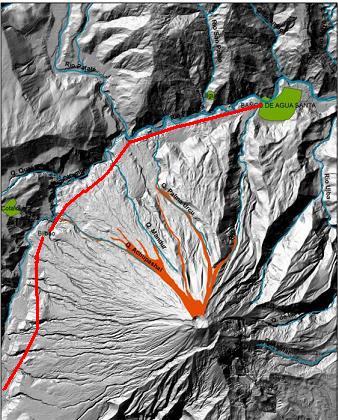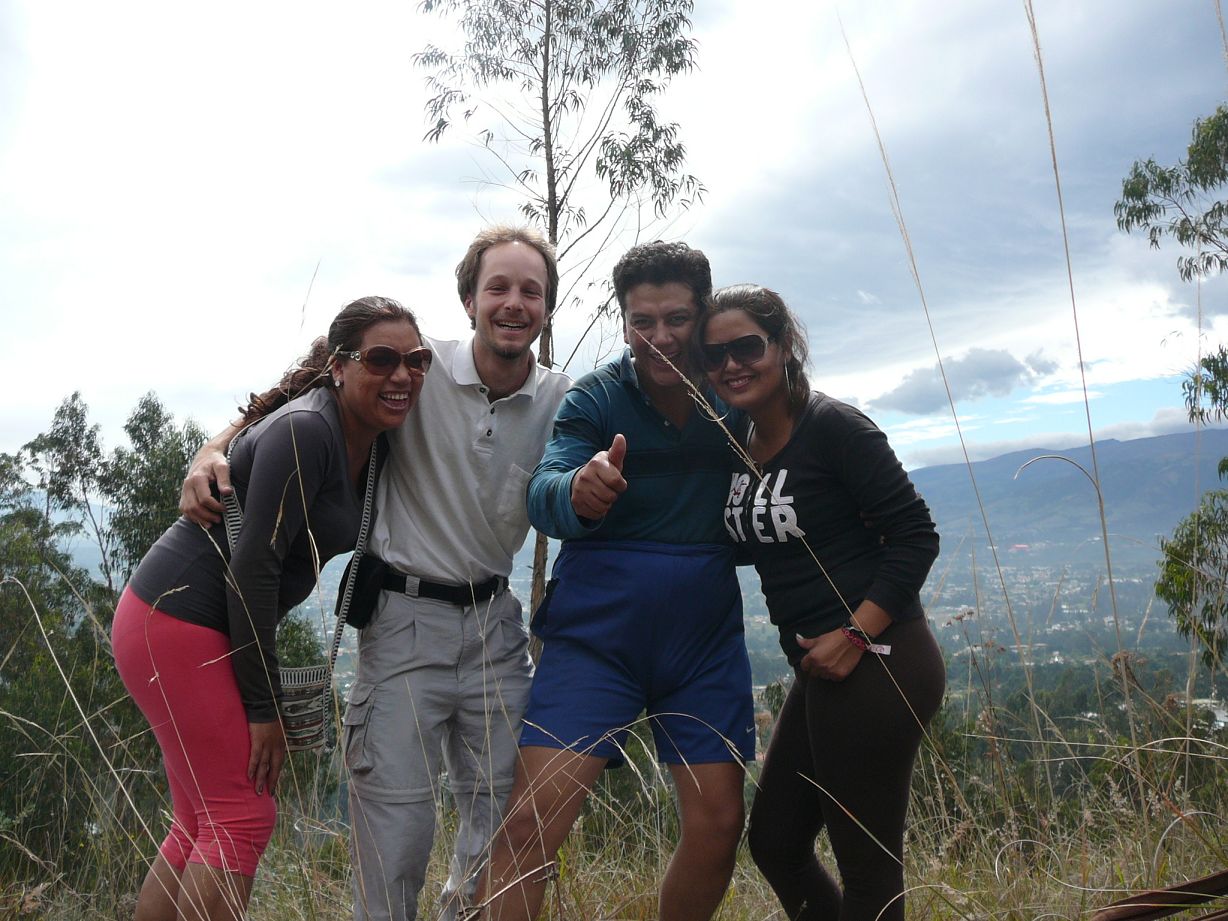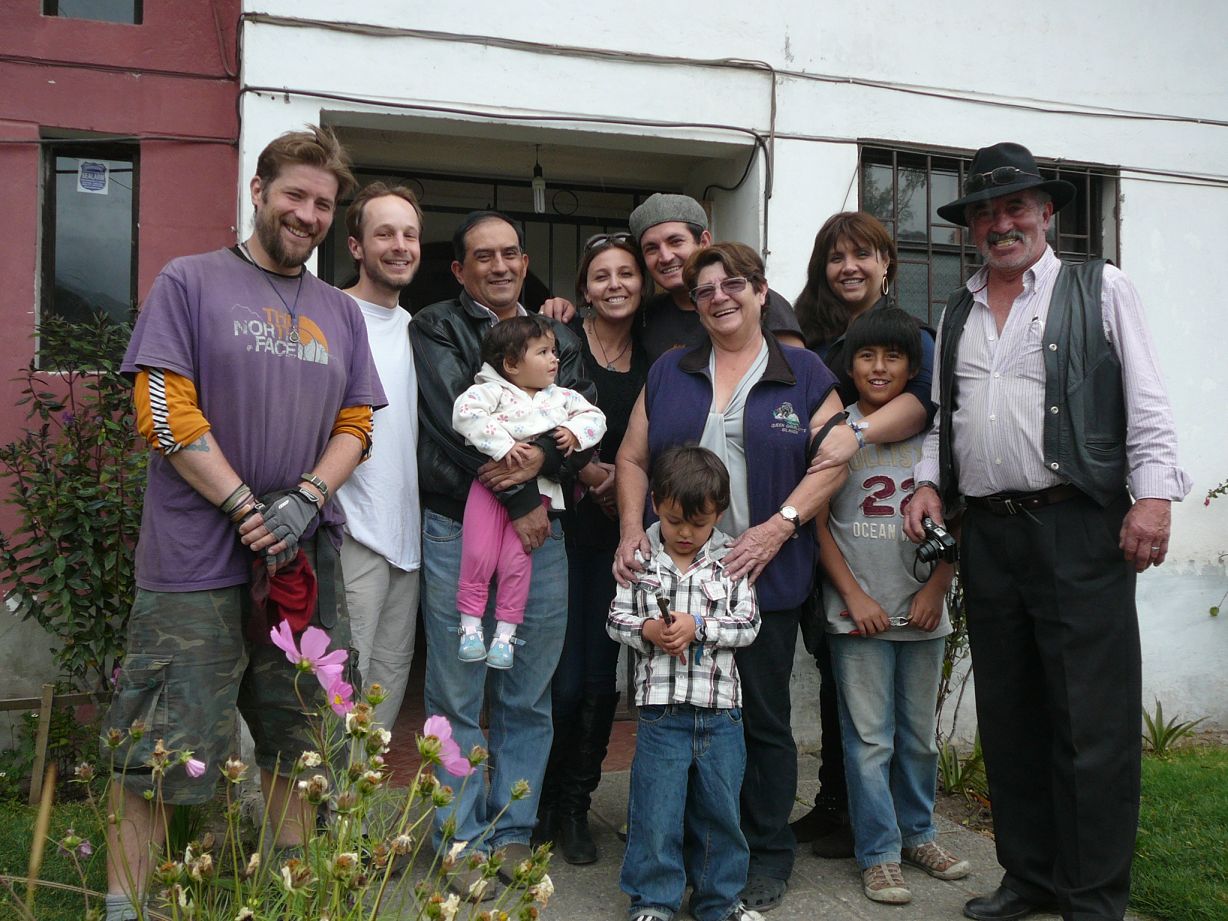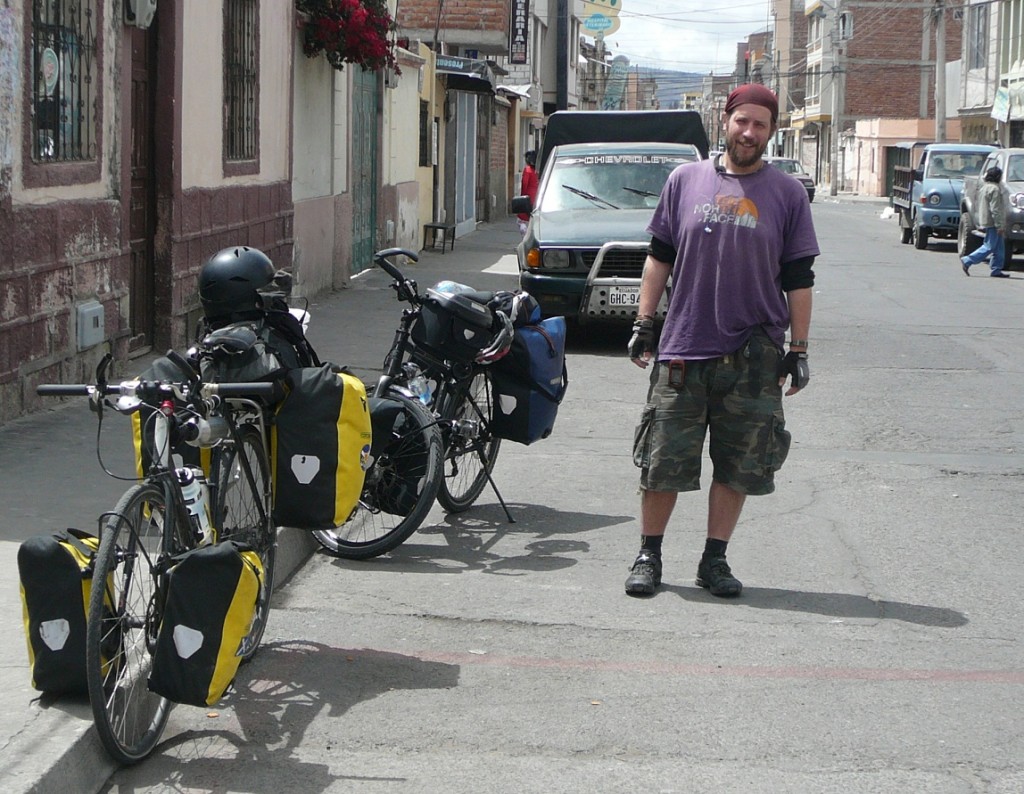Today, after exactly one month together, Andy’s way and mine forked again. He continues the Panamericana southwards, while I try for smaller roads less-travelled with a detour to Macas, in the Amazonas region of Ecuador. I enjoyed the time in his company very much, his laid-back humorous way to deal with daily problems and our discussions on a wide range of topics spanning from the monetary system on the Falkland Islands to the submarine graveyards along the Scotish coastline and the pros and cons of fixed-gear bicycles. Cycling without him will be different: Suerte Andy!
Kategorie-Archiv: Ecuador
No Man’s Land
Wir passierten die Polizeisperre der noch immer geschlossenen Verbindungsstraße nach Riobamba anstandslos: „Tienen una reserva en Penipe? De acuerdo. Pero cuidado!“ Stetig ansteigend, verlor sich die asphaltierte Fahrspur allerdings bald unter den bröckelnden Erdmassen, die die Schlammlawinen des zurückliegenden Ausbruchs hinterlassen hatten. Eine trostlose, unwirtliche Mondlandschaft, die der starke Regen nicht unbedingt gangbarer machte. Hinter einem der Moränenhügel trafen wir das von unserem Anblick völlig überraschte Fernsehteam des Nationalsenders Tele TC, das ein kurzes Interview mit den beiden radelnden gringos in die Abendnachrichten brachte. Einen gehörigen Schreck jagte uns das plötzlich einsetzende nahe Donnern ein, das uns dann, mal lauter, mal ferner, den gesamten Nachmittag über begleitete. Wir hatten am Morgen die unbedenklich lautenden Berichte der lokalen geophysikalischen Beobachtungsstation abgerufen; wie wir aber später erfuhren, hatte sich die vulkanische Aktivität im Tagesverlauf zur ‚orangenen Warnstufe‘ mit pyroklastischen Strömen verstärkt. Uns molestierte davon momentan nur der dichte Nebel und der in den Augen beißende Niederschlag feiner Aschenpartikel, die sich flockenartig auf unseren Jacken und Taschen sammelten. Wie in Trance folgten wir weiter dem Taleinschnitt, zur Linken das Donnern des Tungurahua, in der Mitte des Tals den durch den Regen der vergangenen Tage stark angeschwollenen Río Chambo, auf der rechten Seite steile Geröllhänge, die polternd Gesteinsbrocken hinabsandten. Inmitten dieser rumorenden Urgewalten vereinzelte Wohnhäuser, alle verlassen. Es war ein Anblick wie nach dem zeitlichen und räumlichen Ende der Welt, erhebend und gewaltig, es war ein Erlebnis, das einen das Leben intensiver spüren läßt.
In der Dunkelheit erreichten wir Penipe.
Siehe auch den Bericht von Andy for an english version of this adventure.
Stream Crossing: bitte auf Play klicken!
Falling rocks: Bitte auf Play klicken!

Map of road and pyroclastic flow around the Tungurahua (explosion of 14/07-13) (Source)
Tropenträume
Das ist die hohe Zeit der Tropenträume, / ein Flügelschlag nur bis zum Meer,
und alles, was ich jetzt versäume, / erreicht mich bis ins Grab nicht mehr.Da wuchern wieder Kindheitsträume, / das Wunderland Calafia,
das ich erst spät durch dunkle Räume / im Rausch und Taumel wiedersah.Es ist der alte Rausch der Meere, / der meine Fieberträume nährt.
Dahinter öffnet sich die Leere / und eine Stille, die verzehrt.K. Wecker
Heute Morgen, nach drei Tagen leichten Fieberdeliriums und Kopfschmerzes, war ich beim Arzt, genauer bei drei auf die ganze Kleinstadt gleichmäßig verteilten Arztstationen: die erste empfängt erst wieder ab Mittwoch, der zweiten war der Teststoff ausgegangen, die dritte Station nur ein Laboratorium für Bluttests ohne ärztlichen Rat. Der wortkargen Labordame war tatsächlich nichts zu entlocken. Glücklicherweise konnte sich der medizinische Experte aus meinem Basislager spontan im Onlinechat zuschalten, um das Blutbild zu kommentieren: es handelt sich nicht um eine Malaria-, sondern um eine hartnäckige bakterielle Infektion.
Während der erzwungenen Auszeit las ich im Hostel das dort zufällig herumlungernde Buch rottenegg des Musikmoderators M.Kavka: eine leichtgewichtige Burleske über das Leben in der deutsch-bayrischen Provinz und ein nettes Stück Heimatnostalgie in der fernen Fremde.
Morgen geht’s weiter.
Baños
In Latacunga haben wir uns für eine Exkursion nach Baños, den in jeder Hinsicht ‚westlichsten‘ Vorposten des ecuatorianischen Regenwalds entschieden, für uns ein Umweg von 60km und 2000 Höhenmetern. Aber was heißt ‚Umweg‘ auf einer Reise wie der unseren…
Baños, auf 1800m ü.N.N. am Fuß des aktiven Vulkans Tungurahua gelegen, ist eine ausgesprochen touristische Kleinstadt (18.000 native Einwohner), mit einer Vielzahl von Hostels, Touroperatoren und Pizzerien.
Um dem Rummel zu entrinnen, mieteten wir zwei Fahrräder für die urige Strecke zum Paílón del Diablo, einem gigantischen Wasserfall des Río Verde: nach zwei Kilometern zerlegte sich die Hinterradachse meines betagten Rads.
Trotz dieser durchwachsenen Erfahrung mit der Verläßlichkeit des hiesigen Materials, konnte ich später am Nachmittag, nach dem Rückmarsch nun auf einem neuen Bike, der Versuchung nicht widerstehen, ein Canopy am Weg auszuprobieren, ein 1km langes Drahtseil, das man kopfüber mit bis zu 90km/h in eine Schlucht hinabgleitet.
Unseren Aufbruch am nächsten Morgen verhinderte der neuerliche Ausbruch des Tungurahua: die Verbindungsstraße über Penipe nach Riobamba war vom Lavafluß betroffen und infolgedessen gesperrt. Leider konnten wir aufgrund der dichten Bewölkung bis auf einige Staubwirbel auch später am Abend bei einem Ausflug auf den höhergelegenen Aussichtspunkt de la Virgen nichts von den heißen Vorgängen sehen.
Zuletzt im Jahr 1999 war die gesamte Stadt wegen der starken seismischen Aktivität für mehr als 5 Monate evakuiert worden.
In einem freundlichen Gespräch mit einer ortsansässigen Caña-Verkäuferin bestätigte sich zumindest der erste Teil des häufig strapazierten Zitats von Alex Humboldt:
„Die Ecuadorianer sind seltsame und einmalige Wesen: sie schlafen ganz ruhig mitten unter knisternden Vulkanen, sie leben arm inmitten von unermesslichen Reichtümern und sie freuen sich über traurige Musik.“
Cotopaxi
Cycling the part of the Panamericana between Quito and Ambato that Alex Humboldt once called the „alley of the volcanoes“: nowadays a large highway with at times four lanes in each direction. Black clouds of exhaust from the left, glass splinter on your track, barking dogs from the right and steadily subiendo. But the landscape is indeed marvellous: numerous volcanoes at both sides, the Pasochoa, Illiniza and Rumiñahui.
Reaching in the evening of the second day at last the entry to the Cotopaxi National Park, we sneaked under a fence of barbed wire, which Andi had secured with his carabiner „to comply with German safety standards“, and pitched hiddenly our tents in thick forest at 3500m, the highest I have ever camped. Next day we climbed up to a seemingly abandoned train station in the middle of nowhere and tried to cross over to the base of Cotopaxi whose white cap we saw from far. But the road was broken and after several hours of hard work pushing our bikes over braided paths, we returned to the Panamericana, filled up our pasta supplies and chose another park entrance. Again, we found a nice quiet spot for camping hidden in the forest and enjoyed with the sunset a rich pasta meal from Andi’s stove. After drying our tents from the heavy rain at night, we worked our way up on a perfectly tarmaced, later gravelled road through the beautiful landscape at the mountain base to a campsite at 3800m. As luck would have it, a whole battalion of soldiers had a training session the whole night through which kept me awake for long hours, listening to the wind and pondering confused thoughts.
I’ve set up my alarm clock at 4.30 a.m. to ascend the near volcano Rumiñahui, but when I sticked my head out of the tent, it was all rain and mist and I preferred to stay in the warm sleeping bag for a few hours more. After a pasta breakfast with Andi, I cycled some kilometers up the hill to the lagoon Limpiopungo. The lagoon was not that special, but the landscape was just breathtaking: a large plane at about 3900m altitude in all shades of brown, browsing horses in front of the steep rise to the gleaming white crown of Cotopaxi (5943m).
After striking the tents in a quite strong storm, we enjoyed the long ride of about 25km down to Lasso (lunchtime) and continued on the Panamericana to Latacunga.
With one night of interruption at a pension in Tambillo, we now have camped out for 12 nights. My Nordisk tent suits me perfectly: extremely lightweight, it offers just enough space for me and the luggage and stood uncompromisingly the heavy rain and strong wind at 3800m. Crawling into the tent and closing the zip behind me, I feel on my own, sheltered and comfortably, listening to the sounds of the night, the murmuring wind, the gentle dropping rain. La vida se siente tan libre en estos momentos.

La Casa de Ciclistas
On the way to Quito, on the first climb after Otavalo, we met three heavily laden cyclists, Ignacho, Romina and Javier from Argentina, heading north. In an extended break we exchanged road experiences, directions and hints and they recommended us the casa de ciclistas in Tumbaco, a suburb of Quito. It turned out to be a very lucky suggestion: when we arrived late in the evening, we were picked up by Santiago and Ana Lucia at the central parque and warmly welcomed by the whole family, by Ana Carolina and Micaela, the grandmother and an aunt. Santiago, a ambitious (mountain) cyclist himself, opened his house for world cyclists twenty years ago. Camping in their garden, we enjoyed for one week their friendly hospitality: talking shop about the subtleties of bicycles (Santiago knows and repairs everything), talking about life and travelling and about the churches of Quito (ancient temples). It was a time of recreation, of cultural discoveries and of amity.
And we met there Phil, an adventurous guy, cycling the world for already four years.
El destino triste de viajero es que todas experiencias son pasajeras. Pero estos recuerdos amables nos acompañarán! Todo lo mejor a vosotros!
For a Fistful of Dollars
Tonight, I was robbed by two muchachos in the streets of Tumbaco. It was a short encounter with the brute directness of imposition, the rapid crossing of foreign life lines, the intrusion of characters in my life not chosen to meet deliberately.
I was out for dinner with Lili: we had delicious Tortillas de Papa and humitas, bags of corn, in a traditional restaurant, later two beers and the time passed rapidly with kind chatting about life and future. At about eleven p.m. we walked down a lonely street near the central parque to fetch a cab when behind a passing car two youngsters in hoodie jackets crossed the road to our side. Lili, with an accurate intuition instantly suspicious, began to run while I, just not believing that something like that could ever happen, continued steadily. The first guy stopped me while the other approached me from behind. After a short struggle and a little conversation (que quieren?, que quieren?), they got away with a five dollar note of my wallet. A cheap but important lesson: when in doubt, better run.
Quito
In our two visits, Quito showed us its two faces: the old part in the south, densely peppered with churches from baroque and colonial era, with hilly streets of copple and generous parks and places. And the new part of the city, high-rise buildings of the 70’ies, american hostels in gringolandia and stretched out highways. Quito is beautifully placed on a mountain platform at 2800m with buildings on the ridge to the valley, it is the second highest capital of the world and the only highlands along the ecuator.
The museum of ecuatorian culture impressed us with the highly advanced manufacturing techniques of gold and copper, and together with Carolina from Tabacundo, who spent a few days working in the city, we enjoyed the Capilla del Hombre of the national artist Guayasamín, a haunting memorial for the suffering of mankind. We were honored with the opportunity to visit the governmental palace but did not meet Correa this time. Nevertheless we had a nice discussion about Moreno, one of the most controversial presidents and womanizers in ecuatorian history.
In the bus backwards, passing on a steep road the ancient suburb Guápulo, I met Lili, a merry and pretty girl, who invited me to a hike on a nearby mountain: together with her brother Thomas and his girlfriend Susana we passed a jaunty leisure time on the heights of Quito.

Dancer in the dark
Sometimes, it happens that you just feel in the right place at the right time. We’ve barely built up our tents in the frontyard of a ranch we’ve found along the road when the kind family invited us to the fiesta de San Pedro in Tabacundo. The whole village was on its feet: the man in the clothing of Aruchicos, the women in beautifully woven skirts, and even the children dressed up in traditional midget costumes. The men playing instruments and singing, the women dancing, and, at times, in front of a group passing by, el diablo, cracking the whip. It was only a limited range of songs and melodies, but, in the endless loop, the music captured the bodies and made them the figural and will-less expression of its rhythms. Hovering skirts, swaying hips and stamping feet. You don’t feel lonely in the crowd, what is personality, what is our specific individuality, but you feel closer to the stream of life, just watching, just listening, just moving.
The fiesta lasted for the whole night and the other day.
In the afternoon, together with Carolina, we had the chance to take a ride on some horses of the ranch, for me the first time after about 20 years: it’s not just another means of transport! A horse has his own will and the covered distance is a compromise of your demands and its courtesy.
German, the owner of the Ranch G, a man full of energy and life, last man standing after a long night with Chicha, his own caña liquor, lighted a hellfire to warm us up by the fireside and the night passed rapidly with stories of his hitch-hiker time in Europe. After a hangover breakfast we bid a cordial farewell from this amicable family and hit the road again heading through desert land to Quito.

In the Cotacachi Cayapas Ecological Reserve
Otavalo is mainly known for its Poncho market and the business acumen of its habitants. Since a cycling traveller might take along only memories, we rather planned to ascent the near vulcano Cotacachi (4935m) spending one night in the tents. Looking desperately for hiking boots in the whole village, I could find only shoes up to size 40. I finally squeezed my size 42-feet into one pair. In this moment (and in the many painful moments to come), I somewhat questioned my concept of lightweight travelling: to buy stuff only on the fly, when needed.
Arriving with full-fledged camping equipment at the beautiful Laguna de Cuicocha, a deep blue lake in the former crater, the guardian of the national park prevented us from going further: camping is permitted only with a local guide. After some disappointment, we left the major part of the luggage with him (as I later noticed, we still carried Andi´s heavy stove!) and went for a nice 5 hour tour around the lake.
When we returned at dark, a heavily armed guy guarded our luggage, but, alas!, in deep sleep. To not wake him up, we smuggled silently our luggage out of the open door. Staying the night in a hut at the lagoon, we met David, since 10 years development worker in the region, who told us about the ongoing and dreadful struggle between the Andenean tribes and the big oil companies.
Early the next morning at 4 a.m. we passed again the guardian’s gate to walk up a long and stony road in the mist for a couple of hours. The bright half-moon accompanied us. Here the moon is not standing vertically but lying horizontally like a cradle. We reached the trailhead at 4100m shortly after sunrise. While the view reached even to Quito on the far horizon, the summit was covered by low hanging clouds and proceeding was pointless. Coming back after 8 hours of walk with blisters on my feet, we spent the afternoon watching the lake.


